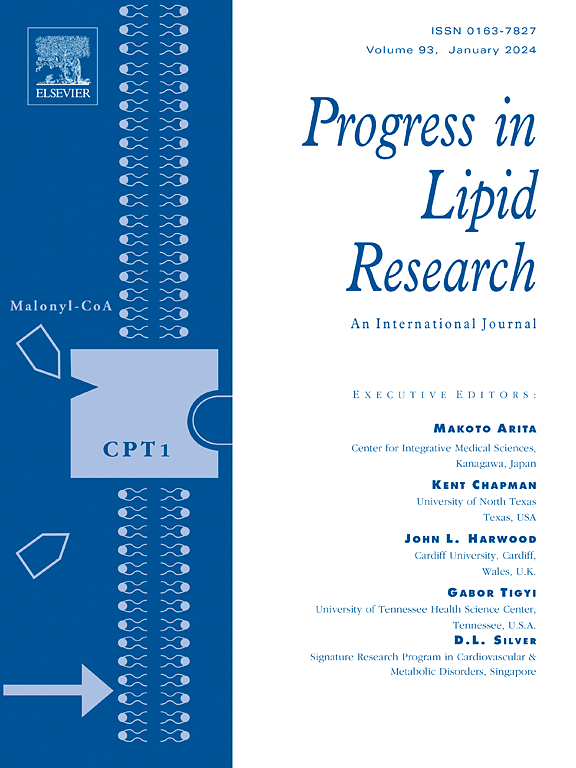The PLAAT family as phospholipid-related enzymes
IF 14
1区 医学
Q1 BIOCHEMISTRY & MOLECULAR BIOLOGY
引用次数: 0
Abstract
The phospholipase A and acyltransferase (PLAAT) family is a group of structurally related proteins that are conserved among vertebrates. In humans, the family comprises five members (PLAAT1–5), which share common domain structures, and functions as phospholipase A1/A2 and acyltransferase enzymes. Regarding acyltransferase activities, PLAATs produce N-acyl-phosphatidylethanolamines, which serve as the precursor of bioactive N-acylethanolamines (NAEs). Recent evidence strongly suggests that PLAAT proteins play a crucial role in maintaining homeostasis in various organelles, such as the endoplasmic reticulum, lysosomes, mitochondria, and peroxisomes. In this process, PLAAT proteins bind to organelles and degrade them in an enzyme activity-dependent manner. Their physiological significance was revealed by the inability of PLAAT-deficient animals to degrade organelles during the maturation of the eye lens, resulting in the development of cataracts. Furthermore, the deficiency of PLAAT1, 3, and 5 in mice caused resistance to high-fat diet-induced fatty liver, the lean phenotype represented by a marked decrease in adipose tissue mass, and the exacerbation of testicular inflammation due to decreased levels of anti-inflammatory NAEs, respectively. In addition, human PLAAT3 was identified as a causative gene for lipodystrophy. We herein provide an overview of the molecular and biological properties of PLAAT proteins.
PLAAT家族作为磷脂相关酶。
磷脂酶A和酰基转移酶(PLAAT)家族是一组在脊椎动物中保守的结构相关蛋白。在人类中,该家族包括5个成员(PLAAT1-5),它们具有共同的结构域结构,并具有磷脂酶A1/A2和酰基转移酶的功能。在酰基转移酶活性方面,plaat产生n -酰基磷脂酰乙醇胺,作为生物活性n -酰基乙醇胺(NAEs)的前体。最近的证据强烈表明,PLAAT蛋白在维持各种细胞器(如内质网、溶酶体、线粒体和过氧化物酶体)的稳态中起着至关重要的作用。在这个过程中,PLAAT蛋白以酶活性依赖的方式与细胞器结合并降解它们。plaat缺乏的动物在晶状体成熟过程中不能降解细胞器,从而导致白内障的发生,揭示了它们的生理意义。此外,小鼠体内PLAAT1、3和5的缺乏分别引起高脂肪饮食诱导的脂肪肝的抵抗,以脂肪组织质量显著减少为代表的瘦表型,以及由于抗炎NAEs水平降低而加剧睾丸炎症。此外,人类PLAAT3被确定为脂肪营养不良的致病基因。本文综述了PLAAT蛋白的分子和生物学特性。
本文章由计算机程序翻译,如有差异,请以英文原文为准。
求助全文
约1分钟内获得全文
求助全文
来源期刊

Progress in lipid research
生物-生化与分子生物学
CiteScore
24.50
自引率
2.20%
发文量
37
审稿时长
14.6 weeks
期刊介绍:
The significance of lipids as a fundamental category of biological compounds has been widely acknowledged. The utilization of our understanding in the fields of biochemistry, chemistry, and physiology of lipids has continued to grow in biotechnology, the fats and oils industry, and medicine. Moreover, new aspects such as lipid biophysics, particularly related to membranes and lipoproteins, as well as basic research and applications of liposomes, have emerged. To keep up with these advancements, there is a need for a journal that can evaluate recent progress in specific areas and provide a historical perspective on current research. Progress in Lipid Research serves this purpose.
 求助内容:
求助内容: 应助结果提醒方式:
应助结果提醒方式:


